Journal Papers by Poh Kam Wong

Journal of Evolutionary Studies of Business, 2022
First conceptualised in Singapore's first National Technology Plan in 1991, the idea of creating ... more First conceptualised in Singapore's first National Technology Plan in 1991, the idea of creating a new integrated R&D and innovation hub in Singapore languished until it was incorporated into a broader Technopreneurship 21 (T21) strategy announced in 1998, and was officially launched in late 2001. In the 20 years since, the innovation district has made significant development progress, but not quite in the manner as presented in a number of prior studies that have adopted a "topdown rational planning" narrative. Taking an evolutionary view, we argue that the actual development of One-North was significantly shaped by a number of critical actors as well as external environmental factors, and its evolutionary trajectory deviated from its original plan. Our evolutionary narrative provides insights on the role of champions in large scale innovation projects, and the need to integrate physical space development within a comprehensive innovation ecosystem development strategy.
Stanford Social Innovation Review 中文版

Asia Pacific Journal of Management , 2019
Building on Cyert and March's (1963) behavioral theory of the firm, we investigate how firms adju... more Building on Cyert and March's (1963) behavioral theory of the firm, we investigate how firms adjust their exploratory and exploitative innovation activities in response to performance feedback, and how this adjustment is moderated by the firms' financial slack. We find that firms invest in a different mix of innovation activities when they receive positive versus negative performance feedback. Specifically, our empirical results show that the higher a firm's performance is above its aspiration level, the lower will be the share of exploratory innovation in its total portfolio of innovation activities. In contrast, the lower a firm's performance is below its aspiration level, the higher will be the share of exploratory innovation in its total innovation activities. While financial slack has the direct effect of increasing the share of exploratory innovation activities, its interaction with performance feedback appears to moderate this effect when the firm is underperforming.

Asia Pacific Journal of Management , 2019
Building on Cyert and March's (1963) behavioral theory of the firm, we investigate how firms adju... more Building on Cyert and March's (1963) behavioral theory of the firm, we investigate how firms adjust their exploratory and exploitative innovation activities in response to performance feedback, and how this adjustment is moderated by the firms' financial slack. We find that firms invest in a different mix of innovation activities when they receive positive versus negative performance feedback. Specifically, our empirical results show that the higher a firm's performance is above its aspiration level, the lower will be the share of exploratory innovation in its total portfolio of innovation activities. In contrast, the lower a firm's performance is below its aspiration level, the higher will be the share of exploratory innovation in its total innovation activities. While financial slack has the direct effect of increasing the share of exploratory innovation activities, its interaction with performance feedback appears to moderate this effect when the firm is underperforming.
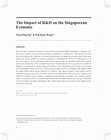
STI Policy Review, Aug 2017
There has been a pronounced increase in research and development (R&D) expenditure in Singapore o... more There has been a pronounced increase in research and development (R&D) expenditure in Singapore over the last two decades, with government spending accounting for a sizeable share. This increase has been spurred by public policy emphasis on research and innovation as engines of economic growth. This paper analyses the impact of R&D on economic performance in Singapore from 1978 to 2012 through the use of time series analysis. The Cobb-Douglas based analysis shows a long-run equilibrium relationship between Total Factor Productivity (TFP) and R&D investments. We found that the short-run productivity of R&D in Singapore is comparable to smaller advanced economies in the Organisation for Economic Co-operation and Development (OECD). However, in terms of long-run R&D productivity, Singapore lags slightly behind the smaller OECD nations and far behind the G7 countries. This suggests leakage of value capture and low absorptive capacity in local firms. Possibility of productivity improvements induced by policy changes in the 1990s was considered, but no evidence of significant structural breaks was found. Lastly, Granger causality analysis reveals that public sector R&D augments private sector R&D capital, thus playing an important role in generating externalities and spillover effects. Policy implications and lessons for other middle-income countries are discussed.

This paper outlines a scheme that uses manpower from public research institutes to assist the tec... more This paper outlines a scheme that uses manpower from public research institutes to assist the technology upgrading of Small-and-Medium-sized Enterprises (SMEs). The Growing Enterprises through Technology Upgrading (GET-Up) initiative has been successfully implemented in Singapore since 2003. The key program in the initiative is a manpower secondment scheme (i.e. a temporary placement of manpower in a different organization) known as T-Up. We propose that T-Up represents a new approach to technology transfer which additionally maximizes the industrial impact of public sector research. Instead of traditional technology transfer modes which are transactions-based, T-Up utilizes skills and human resource transfer through secondment of public sector researchers. Findings from two surveys conducted in 2005 and 2012 show that the T-Up secondment program had positive impact on the technological capabilities, innovation performance and growth of participating companies. Additionally, case studies highlight that this approach addresses a wide range of challenges faced by local SMEs and is flexible enough to cater to specific needs and requirements.
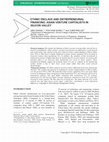
Research summary: We examine the dilemma of ethnic investors in using ethnic network ties to inve... more Research summary: We examine the dilemma of ethnic investors in using ethnic network ties to invest by extending the 'ethnic enclave' concept to incorporate two dimensions: social network and social status. Our analysis of the first round of venture capital funding in Silicon Valley from 1976 to 2004 shows a higher likelihood of Asian venture capitalists (VCs) investing in Asian-led ventures than mainstream VCs. In addition, the valuation of their investments in mainstream ventures is higher than those by mainstream VCs in such ventures. In contrast, this premium effect is not observed when mainstream VCs invest in Asian ventures. These asymmetrical findings suggest the premium Asian VCs pay to compete in the mainstream venture market is due to their lower social status rather than their social network disadvantages. Managerial summary: Do ethnic minority investors behave differently from more mainstream investors? We examine this question by studying the venture capital industry in Silicon Valley over the period 1976 to 2004. We found that Asian venture capitalists (VCs) were more likely to invest in immigrant Asian entrepreneurs than mainstream VCs, and when they did invest in mainstream ventures, they paid higher valuations than mainstream VCs. In contrast, mainstream VCs did not pay higher average valuations compared to Asian VCs when they invested in Asian ventures. We show that two social factors—the ethnic minority VCs' social network ties and their lower social status—could have contributed to such behavioral differences.
This is an introduction of four case studies, conducted at different universities in Asia and Eur... more This is an introduction of four case studies, conducted at different universities in Asia and Europe, on university-industry research cooperation and related interactions.

The Triple Helix model highlights the "third mission" of universities to engage in IP (intellectu... more The Triple Helix model highlights the "third mission" of universities to engage in IP (intellectual property) creation and technology transfer activities further downstream. This paper uses publications data and US patent data to examine the role played by leading research-intensive universities in the national innovation systems of the emerging economy of China and the newly industrialised economies (NIE) of Singapore, Hong Kong, Korea and Taiwan. Our analysis highlights significant differences amongst these five East Asian economies, and also reveals contrasts to observed patterns in the US and Europe. Our findings confirm that universities in the five economies have increased their contribution to their respective national innovation systems in terms of research output and R&D collaboration. The NIE universities experienced rapid patent growth rates over 1995-2005, followed by Chinese universities in the subsequent period of 2006-2010. However, the contribution of universities in all five East Asian economies to the total volume of IP creation in their economies generally remains low. Moreover, patent quality is low compared to patents from non-university sectors, suggesting weak technological commercialisation impacts.

Asia Pacific Journal of Management, Vol 31 No. 5 (Dec 2014): 1-25
Prior research on firm behavior in emerging economies like China has highlighted the extensive bu... more Prior research on firm behavior in emerging economies like China has highlighted the extensive building and use of political ties by business managers. However, there are mixed findings regarding the value of political ties on firm performance. In this study, we propose a task-contingency approach to explain when the investment in political ties will improve performance and when they will not. In particular, we study how the value of investing managerial time to cultivate political ties with local government officials may vary when firms engage in different types of technological innovation activities. We hypothesize that when a firm pursues exploratory innovation involving high institutional uncertainty, such time investment will improve firm performance. In contrast, when a firm undertakes exploitative innovation that involves low institutional uncertainty but requires high internal operational improvement such as marketing and sales, such time investment in political ties would distract managers’ attention from internal improvement, and hence may harm firm performance. Results based on a World Bank survey of 1,500 Chinese manufacturing firms confirm these hypotheses. Our findings offer fresh insights on how firm managers in emerging economies should manage their institutional environment when pursuing innovation activities.

As a catalyst for endogenous technological change, inward technology licensing (ITL) can improve ... more As a catalyst for endogenous technological change, inward technology licensing (ITL) can improve a firm’s innovation performance. This paper investigates the effect of learning by licensing and choice of licensed-in technologies on innovation performance. We extend the ITL strategy to the latecomer context, addressing two critical factors: (1) number of licenses and (2) age of
licensed-in technology. We hypothesize about the relationship of the licensee’s
innovation performance with the number of licenses and age of licensed-in
technology, as well as the moderating effect of the licensee’s absorptive capacity. Based on a sample of 154 Chinese high-tech firms, empirical evidence is found in support of our arguments. This study is the first to consider the significance of the age of licensed-in technology to innovation performance and found that the number of licenses has a curvilinear (an inverted U) relationship with innovation performance. We also confirmed the significant moderating effect of absorptive capacity on the above two relationships.
Keywords: inward technology licensing; licenses; technology age; latecomer; absorptive capacity
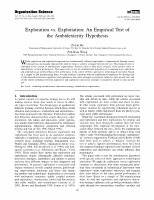
While exploration and exploitation represent two fundamentally different approaches to organizati... more While exploration and exploitation represent two fundamentally different approaches to organizational learning, recent literature has increasingly indicated the need for firms to achieve a balance between the two. This balanced view is embedded in the concept of ambidextrous organizations. However, there is little direct evidence of the positive effect of ambidexterity on firm performance. This paper seeks to test the ambidexterity hypothesis by examining how exploration and exploitation can jointly influence firm performance in the context of firms’ approach to technological innovation. Based on a sample of 206 manufacturing firms, we find evidence consistent with the ambidexterity hypothesis by showing that (1) the interaction between explorative and exploitative innovation strategies is positively related to sales growth rate, and (2) the relative imbalance between explorative and exploitative innovation strategies is negatively related to sales growth rate.
Key words: technological innovation; innovation strategy; ambidextrous organization
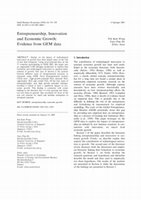
"ABSTRACT. Studies on the impact of technological innovation on growth have been largely mute on ... more "ABSTRACT. Studies on the impact of technological innovation on growth have been largely mute on the role of new firm formation. Using cross-sectional data on the 37 countries participating in GEM 2002, this paper uses an augmented Cobb–Douglas production to explore firm formation and technological innovation as separate determinants of growth. One area of interest is the contrast between different types of entrepreneurial activities as measured using GEM Total Entrepreneurial Activity (TEA) rates – high growth potential TEA, necessity TEA, opportunity TEA and overall TEA. Of the four types of entrepreneurship, only high growth potential entrepreneurship is found to have a significant impact on economic growth. This finding is consistent with extant findings in the literature that it is fast growing new firms, not new firms in general, that accounted for most of the new job creation by small and medium enterprises in advanced countries.
KEY WORDS: entrepreneurship, economic growth."

Using the university–industry co-publications (UICP) propensity indicators developed by Tijssen (... more Using the university–industry co-publications (UICP) propensity indicators developed by Tijssen (CWTS Working Paper Series, CWTS-WP-2012-009, 2009), this paper examines the impact of university–industry R&D collaboration on university technology
commercialization output for leading US and Canadian universities. Our analysis suggests that UICPs do have a significant positive influence on universities’ technology
commercialization outputs, after controlling for the quantity and quality of their research and for their commercialization resources. The results are robust for all three common measures of university technology commercialization: patenting (both in terms of simple
patent counts and citation-weighted counts), spin-off formation, and technology licensing. To supplement the aggregate regression findings, five case studies are provided that offer
further insights on the causal mechanisms involved. Implications of these findings and possible future research directions are discussed.

A large body of research has thoroughly discussed and examined agglomeration advantages for innov... more A large body of research has thoroughly discussed and examined agglomeration advantages for innovation of geographically concentrated firms. However, there is an increasing awareness that this intellectual tradition tends to overemphasize the role of geographic proximity in the transfer of knowledge between firms and to under-theorize the contribution of nonlocal knowledge flows. With a sample of 143 manufacturing firms from
Singapore, this research attempts to answer three interrelated questions: (1) Does local networking effort provide firms with added value above and beyond what is available to them by just “being there?” (2) Does local collaboration contribute more to innovation performance than nonlocal collaboration? (3) What is the joint impact of local and nonlocal collaborations on innovation performance? We find that while local and nonlocal collaborations are statistically indistinguishable from each other in terms of their relative importance, they represent complementary spurs to innovation. Despite the unique research setting of Singapore as a city state, we argue that our findings may be generalizable to geographic systems in other parts of the world.
KEY WORDS: innovation collaboration, local and global, innovation performance, Singapore
"An individual's intent to pursue an entrepreneurial career can result from the work environment ... more "An individual's intent to pursue an entrepreneurial career can result from the work environment and from personal factors. Drawing on the entrepreneurial intentions and the person–environment (P–E) fit literatures, and applying a multilevel perspective, we examine why individuals intend to leave their jobs to start business ventures. Findings, using a sample of
4192 IT professionals in Singapore, suggest that work environments with an unfavorable innovation climate and/or lack of technical excellence incentives influence entrepreneurial
intentions, through low job satisfaction. Moderating effects suggest that an individual's innovation orientation strengthens the work-environment to job-satisfaction relationship; selfefficacy
strengthens the job-satisfaction to entrepreneurial intentions relationship.
Keywords:Entrepreneurial intentions, Job satisfaction, Self-efficacy"
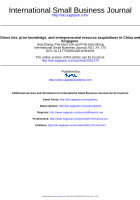
The entrepreneurship literature suggests that network ties are useful in mitigating the problem o... more The entrepreneurship literature suggests that network ties are useful in mitigating the problem of information asymmetry faced by entrepreneurs when acquiring resources at the early stage of
venture creation. We introduce prior knowledge of resource owners as an inverse measure of information asymmetry and investigate the contingent effect of prior knowledge and tie strength between entrepreneurs and resource owners on the likelihood of entrepreneurial resource acquisition. Using data from 378 high-tech ventures located in Beijing, China and Singapore, the analysis shows that strong ties are more important than weak ties, in entrepreneurs’ resource
acquisition and this importance grows when resource owners have less prior knowledge to offset problems of information asymmetry. Similar network effects are found in both China and
Singapore. The insignificant country difference suggests that the social network culture of the start-up community is universal.
Keywords
direct ties, prior knowledge, resource acquisition
This study investigates when indirect ties, in which a referrer appears between an entrepreneur a... more This study investigates when indirect ties, in which a referrer appears between an entrepreneur and a resource owner, can enhance the likelihood of resource acquisitions for starting a new venture. The authors argue that when either resource owners or referrers possess a greater level of prior knowledge about a venture’s technology or product, information asymmetry problems arising from weak component ties decline, enabling resource owners to evaluate the venture better. On the basis of survey data from 378 high-tech entrepreneurs, the analysis shows that resource owners’ prior knowledge, but not referrers’, compensates for limited information in weak component ties better than in strong component ties.
Keywords: social networks; entrepreneurial resource acquisition; indirect ties; prior knowledge











Uploads
Journal Papers by Poh Kam Wong
licensed-in technology. We hypothesize about the relationship of the licensee’s
innovation performance with the number of licenses and age of licensed-in
technology, as well as the moderating effect of the licensee’s absorptive capacity. Based on a sample of 154 Chinese high-tech firms, empirical evidence is found in support of our arguments. This study is the first to consider the significance of the age of licensed-in technology to innovation performance and found that the number of licenses has a curvilinear (an inverted U) relationship with innovation performance. We also confirmed the significant moderating effect of absorptive capacity on the above two relationships.
Keywords: inward technology licensing; licenses; technology age; latecomer; absorptive capacity
Key words: technological innovation; innovation strategy; ambidextrous organization
KEY WORDS: entrepreneurship, economic growth."
commercialization output for leading US and Canadian universities. Our analysis suggests that UICPs do have a significant positive influence on universities’ technology
commercialization outputs, after controlling for the quantity and quality of their research and for their commercialization resources. The results are robust for all three common measures of university technology commercialization: patenting (both in terms of simple
patent counts and citation-weighted counts), spin-off formation, and technology licensing. To supplement the aggregate regression findings, five case studies are provided that offer
further insights on the causal mechanisms involved. Implications of these findings and possible future research directions are discussed.
Singapore, this research attempts to answer three interrelated questions: (1) Does local networking effort provide firms with added value above and beyond what is available to them by just “being there?” (2) Does local collaboration contribute more to innovation performance than nonlocal collaboration? (3) What is the joint impact of local and nonlocal collaborations on innovation performance? We find that while local and nonlocal collaborations are statistically indistinguishable from each other in terms of their relative importance, they represent complementary spurs to innovation. Despite the unique research setting of Singapore as a city state, we argue that our findings may be generalizable to geographic systems in other parts of the world.
KEY WORDS: innovation collaboration, local and global, innovation performance, Singapore
4192 IT professionals in Singapore, suggest that work environments with an unfavorable innovation climate and/or lack of technical excellence incentives influence entrepreneurial
intentions, through low job satisfaction. Moderating effects suggest that an individual's innovation orientation strengthens the work-environment to job-satisfaction relationship; selfefficacy
strengthens the job-satisfaction to entrepreneurial intentions relationship.
Keywords:Entrepreneurial intentions, Job satisfaction, Self-efficacy"
venture creation. We introduce prior knowledge of resource owners as an inverse measure of information asymmetry and investigate the contingent effect of prior knowledge and tie strength between entrepreneurs and resource owners on the likelihood of entrepreneurial resource acquisition. Using data from 378 high-tech ventures located in Beijing, China and Singapore, the analysis shows that strong ties are more important than weak ties, in entrepreneurs’ resource
acquisition and this importance grows when resource owners have less prior knowledge to offset problems of information asymmetry. Similar network effects are found in both China and
Singapore. The insignificant country difference suggests that the social network culture of the start-up community is universal.
Keywords
direct ties, prior knowledge, resource acquisition
Keywords: social networks; entrepreneurial resource acquisition; indirect ties; prior knowledge
licensed-in technology. We hypothesize about the relationship of the licensee’s
innovation performance with the number of licenses and age of licensed-in
technology, as well as the moderating effect of the licensee’s absorptive capacity. Based on a sample of 154 Chinese high-tech firms, empirical evidence is found in support of our arguments. This study is the first to consider the significance of the age of licensed-in technology to innovation performance and found that the number of licenses has a curvilinear (an inverted U) relationship with innovation performance. We also confirmed the significant moderating effect of absorptive capacity on the above two relationships.
Keywords: inward technology licensing; licenses; technology age; latecomer; absorptive capacity
Key words: technological innovation; innovation strategy; ambidextrous organization
KEY WORDS: entrepreneurship, economic growth."
commercialization output for leading US and Canadian universities. Our analysis suggests that UICPs do have a significant positive influence on universities’ technology
commercialization outputs, after controlling for the quantity and quality of their research and for their commercialization resources. The results are robust for all three common measures of university technology commercialization: patenting (both in terms of simple
patent counts and citation-weighted counts), spin-off formation, and technology licensing. To supplement the aggregate regression findings, five case studies are provided that offer
further insights on the causal mechanisms involved. Implications of these findings and possible future research directions are discussed.
Singapore, this research attempts to answer three interrelated questions: (1) Does local networking effort provide firms with added value above and beyond what is available to them by just “being there?” (2) Does local collaboration contribute more to innovation performance than nonlocal collaboration? (3) What is the joint impact of local and nonlocal collaborations on innovation performance? We find that while local and nonlocal collaborations are statistically indistinguishable from each other in terms of their relative importance, they represent complementary spurs to innovation. Despite the unique research setting of Singapore as a city state, we argue that our findings may be generalizable to geographic systems in other parts of the world.
KEY WORDS: innovation collaboration, local and global, innovation performance, Singapore
4192 IT professionals in Singapore, suggest that work environments with an unfavorable innovation climate and/or lack of technical excellence incentives influence entrepreneurial
intentions, through low job satisfaction. Moderating effects suggest that an individual's innovation orientation strengthens the work-environment to job-satisfaction relationship; selfefficacy
strengthens the job-satisfaction to entrepreneurial intentions relationship.
Keywords:Entrepreneurial intentions, Job satisfaction, Self-efficacy"
venture creation. We introduce prior knowledge of resource owners as an inverse measure of information asymmetry and investigate the contingent effect of prior knowledge and tie strength between entrepreneurs and resource owners on the likelihood of entrepreneurial resource acquisition. Using data from 378 high-tech ventures located in Beijing, China and Singapore, the analysis shows that strong ties are more important than weak ties, in entrepreneurs’ resource
acquisition and this importance grows when resource owners have less prior knowledge to offset problems of information asymmetry. Similar network effects are found in both China and
Singapore. The insignificant country difference suggests that the social network culture of the start-up community is universal.
Keywords
direct ties, prior knowledge, resource acquisition
Keywords: social networks; entrepreneurial resource acquisition; indirect ties; prior knowledge
This paper examines the challenges that Singapore faces in seeking to do so, through an explorative survey of 40 firms from three innovative sectors: high-tech manufacturing industries, knowledge intensive business services (KIBS), and creative content industries. Overall, while the survey confirms Singapore’s continuing competitive strength in efficiency infrastructure, it also finds a favorable perception of Singapore as an innovative city. Indeed, many of the industry actors indicated that an efficient business infrastructure is a pre-requisite for their locating
their innovative activities in Singapore, suggesting that the relationship between innovation and efficiency is complementary rather than substitutional. While the study found that intellectual property (IP) and its protection are widely recognized by actors in all three sectors, interesting differences exist. In particular, intellectual property protection appears to be of greater concern to the high-tech, research-and-development-intensive manufacturing sector and the creative contents sector than to the KIBS sector. Another interesting difference is that while competition in high-tech innovation tends to be global, competition in creative content tends to have a stronger local or regional dimension. Public policy in East Asia has traditionally emphasized the development of technological innovation capabilities in the manufacturing sector. In light of our study findings, public policy makers may need to be more sensitive to the nuanced differences in policies needed to promote the new creative content industries and the associated supporting KIBS.
different models of national innovation system. This paper presents an analytical framework for characterizing the generic evolutionary paths for rapid technological catch-up by late-industrializing countries. The framework seeks to integrate three
theoretical perspectives: the resource-based view of the firm, the network interaction perspective on the technological learning process, and the institutional economics perspective on the contexts of late-industrialization. The framework is found to be
useful in explaining the divergent evolutionary patterns among these three distinct national innovation systems. The framework also highlights potential limits of the respective innovation systems as the catch-up process reaches an advanced stage, and
suggests new directions for change. Implications for future research on national innovation system for late-industrializing countries are explored.
Keywords: technology transfer, Public Research Institutes (PRIs), Small-and-Medium-sized Enterprises (SMEs), open innovation
This survey report forms part of the deliverables of the study. Various aspects of this survey report were presented in seminars in Indonesia and Singapore, among them a BBK Competitiveness Seminar in Jakarta co-organised by the Ministry of Trade, Indonesia, FEUI and ACI. The opening address of this seminar in Jakarta was given by the Trade Minister of Indonesia, Ibu Dr. Marie Elka Pangestu and the seminar was attended by about 200 participants, including stakeholders of the development of BBK, government officials and academia.